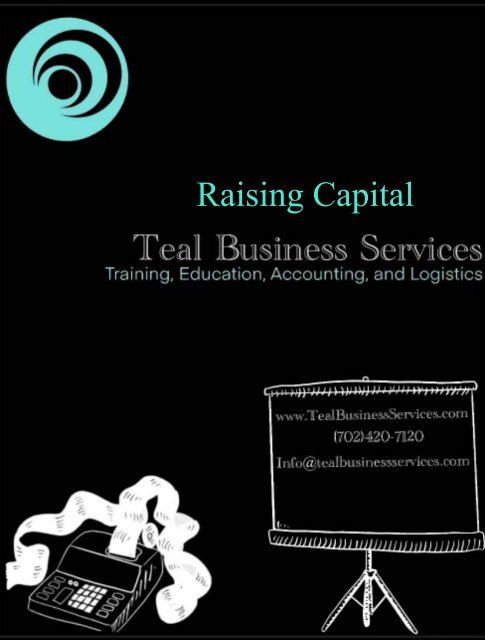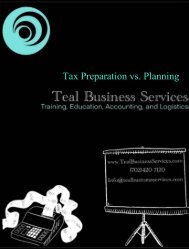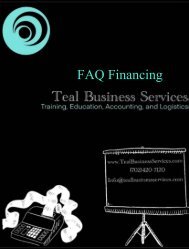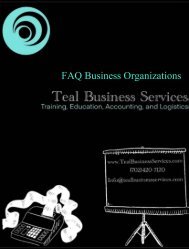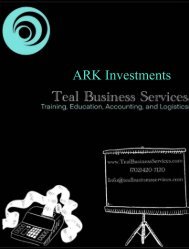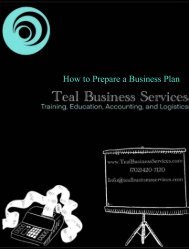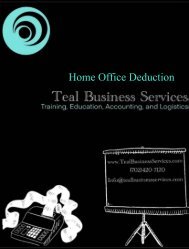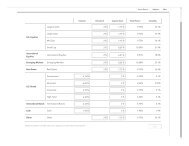Raising Capital
Create successful ePaper yourself
Turn your PDF publications into a flip-book with our unique Google optimized e-Paper software.
<strong>Raising</strong> <strong>Capital</strong>
In addition to drive, ambition and a great deal of planning, starting and expanding a<br />
small business generally requires capital. <strong>Capital</strong> may come from family, friends, lenders<br />
or others. This Financial Guide provides an overview of how to get the capital you need<br />
to start or grow your business.<br />
Table of Contents<br />
• Finding Sources Of Money<br />
• Borrowing Money<br />
• How To Write A Loan Proposal<br />
• How Your Loan Request Will Be Reviewed<br />
• SBA Programs<br />
• Quick Reference to SBA Loan Programs<br />
• Government and Non-Profit Agencies<br />
One key to successful business start-up and expansion is your ability to obtain and<br />
secure appropriate financing. <strong>Raising</strong> capital is one of the most basic of all business<br />
activities. But as many new entrepreneurs quickly discover, raising capital may not be<br />
easy. In fact, it can be a complex and frustrating process and professional guidance<br />
should be considered, especially with regard to financial information needed for the<br />
loan proposal. This Financial Guide focuses on ways a small business can raise money<br />
and explains how to prepare a loan proposal.<br />
Finding Sources of Money<br />
There are several sources to consider when looking for financing. It is important to<br />
explore all of your options before making a decision. These include:<br />
• Personal Savings. The primary source of capital for most new businesses comes<br />
from savings and other forms of personal resources. While credit cards are often<br />
used to finance business needs, there may be better options available, even for<br />
very small loans.<br />
• Friends and Relatives. Many entrepreneurs look to private sources such as<br />
friends and family when starting out in a business venture. Often, money is<br />
loaned interest free or at a low interest rate, which can be beneficial when getting<br />
started.<br />
• Banks and Credit Unions. The most common source of funding, banks and<br />
credit unions, will provide a loan if you can show that your business proposal is<br />
sound.
• Venture <strong>Capital</strong> Firms. These firms help expanding companies grow in exchange<br />
for equity or partial ownership.<br />
Borrowing Money<br />
It is often said that small business people have a difficult time borrowing money, but<br />
this is not necessarily true. Banks make money by lending money; however, the<br />
inexperience of many small business owners in financial matters often prompts banks to<br />
deny loan requests.<br />
Requesting a loan when you are not properly prepared sends a signal to your lender.<br />
That message is: "High Risk!" To be successful in obtaining a loan, you must be prepared<br />
and organized. You must know exactly how much money you need, why you need it,<br />
and how you will pay it back. You must be able to convince your lender that you are a<br />
good credit risk.<br />
Terms of loans may vary from lender to lender, but there are two basic types of loans:<br />
short-term and long-term.<br />
A short-term loan generally has a maturity date of one year. These include working<br />
capital loans, accounts receivable loans, and lines of credit.<br />
Long-term loans generally mature between one and seven years. Real estate and<br />
equipment loans are also considered long-term loans but may have a maturity date of<br />
up to 25 years. Long-term loans are used for major business expenses such as<br />
purchasing real estate and facilities, construction, durable equipment, furniture and<br />
fixtures, vehicles, etc.<br />
How to Write a Loan Proposal<br />
Approval of your loan request depends on how well you present yourself, your business<br />
and your financial needs to a lender. Remember, lenders want to make loans, but they<br />
must make loans they know will be repaid. The best way to improve your chances of<br />
obtaining a loan is to prepare a written proposal.<br />
A good loan proposal will contain the following key elements:<br />
General Information<br />
• Business name, names of principals, social security number for each principal, and<br />
the business address.
• Purpose of the loan: exactly what the loan will be used for and why it is needed.<br />
• Amount required: the exact amount you need to achieve your purpose.<br />
Business Description<br />
• History and nature of the business: details of what kind of business it is, its age,<br />
number of employees and current business assets.<br />
• Ownership structure: details on your company's legal structure.<br />
Management Profile<br />
Develop a short statement on each principal in your business; provide background,<br />
education, experience, skills, and accomplishments.<br />
Market Information<br />
Clearly define your company's products as well as your markets. Identify your<br />
competition and explain how your business competes in the marketplace. Profile your<br />
customers and explain how your business can satisfy their needs.<br />
Financial Information<br />
• Financial statements: balance sheets and income statements for the past three<br />
years. If you are just starting out, provide projected balance sheets and income<br />
statements.<br />
• Personal financial statements on yourself and other principal owners of the<br />
business.<br />
• Collateral you would be willing to pledge as security for the loan.<br />
How Your Loan Request Will Be Reviewed<br />
When reviewing a loan request, the bank official is primarily concerned about<br />
repayment. To help determine this ability, many loan officers will order a copy of your<br />
business credit report from a credit-reporting agency. Therefore, you should work with<br />
these agencies to help them present an accurate picture of your business. Using the<br />
credit report and the information you have provided, the lending officer will consider<br />
the following issues:
• Have you invested savings or personal equity in your business totaling at least 25<br />
to 50 percent of the loan you are requesting? (Remember, a lender or investor<br />
will not finance 100 percent of your business.)<br />
• Do you have a sound record of credit-worthiness as indicated by your credit<br />
report, work history and letters of recommendation? This is very important.<br />
• Do you have sufficient experience and training to operate a successful business?<br />
• Have you prepared a loan proposal and business plan that demonstrate your<br />
understanding of and commitment to the success of the business?<br />
• Does the business have sufficient cash flow to make the monthly payments on<br />
the amount of the loan request?<br />
SBA Programs<br />
The SBA offers a variety of financing options for small businesses. The SBA's assistance<br />
usually is in the form of loan guarantees; i.e., it guarantees loans made by banks and<br />
other private lenders to small business clients. Generally, the SBA can guarantee up to<br />
$3.75 million or 75 percent of the total loan value. The average size of an SBAguaranteed<br />
loan is $368,737.<br />
Whether you are looking for a long-term loan for machinery and equipment, a general<br />
working capital loan, a revolving line of credit, or a "microloan," the SBA has a financing<br />
program to fit your needs.<br />
The SBA guaranteed more than 50,000 loans totaling $19.2 billion to America's small<br />
businesses small businesses in fiscal year 2014 that otherwise would not have had such<br />
access to capital. It also provides assistance to small businesses and aspiring<br />
entrepreneurs through its Small Business Development Centers located throughout the<br />
United States and its territories.<br />
The 7(a) Loan Guaranty Program, financing that can satisfy the requirements of almost<br />
any new or growing small business. The SBA offers a number of specialized loan and<br />
lender delivery programs.<br />
• 7(a) Loan and 7(m) Microloan Programs<br />
• CAPLines Program<br />
• Export Working <strong>Capital</strong> and International Trade Loans<br />
• Disaster Assistance Loans<br />
• SBA Express<br />
• Certified Development Company (CDC) 504 Loan Program
The 7(a) Loan Guaranty Program<br />
The 7(a) Loan Guaranty Program is the SBA's primary loan program. The SBA reduces<br />
risk to lenders by guaranteeing major portions of loans made to small businesses. This<br />
enables the lenders to provide financing to small businesses when funding is otherwise<br />
unavailable on reasonable terms.<br />
The eligibility requirements and credit criteria of the program are very broad in order to<br />
accommodate a wide range of financing needs.<br />
When a small business applies to a lending institution for a loan, the lender reviews the<br />
application and decides if it merits a loan on its own or if it requires additional support<br />
in the form of an SBA guaranty. SBA backing on the loan is then requested by the<br />
lender. In guaranteeing the loan, the SBA assures the lender that, in the event, the<br />
borrower does not repay the loan, the government will reimburse the lender for its loss.<br />
By providing this guaranty, the SBA helps tens of thousands of small businesses every<br />
year get financing they would not otherwise obtain.<br />
To qualify for an SBA guaranty, a small business must meet the 7(a) criteria and the<br />
lender must certify that it could not provide funding on reasonable terms except with an<br />
SBA guaranty. SBA can guarantee as much as 85 percent on loans of up to $150,000 and<br />
75 percent on loans of more than $150,000. SBA's maximum exposure amount is<br />
$3,750,000. Thus, if a business receives an SBA-guaranteed loan for $5 million, the<br />
maximum guarantee to the lender will be $3,750,000 or 75 percent. SBA Express loans<br />
have a maximum guarantee set at 50 percent.<br />
How The Procedure Works. You submit a loan application to a lender for initial review.<br />
If the lender approves the loan subject to an SBA guaranty, a copy of the application<br />
and a credit analysis are forwarded by the lender to the nearest SBA office. After SBA<br />
approval, the lending institution closes the loan and disburses the funds; you make<br />
monthly loan payments directly to the lender. As with any loan, you are responsible for<br />
repaying the full amount of the loan. There are no balloon payments, prepayment<br />
penalties, application fees or points permitted with 7(a) loans. Repayment plans may be<br />
tailored to each individual business.<br />
Permissible Use of Proceeds. You can use a 7(a) loan to expand or renovate facilities;<br />
purchase machinery, equipment, fixtures and leasehold improvements; finance<br />
receivables and augment working capital; refinance existing debt (with compelling<br />
reason); finance seasonal lines of credit; construct commercial buildings; and/or<br />
purchase land or buildings.
Terms. The SBA's loan programs are generally intended to encourage longer term<br />
small-business financing. However, actual loan maturities are based on the ability to<br />
repay, the purpose of the loan proceeds and the useful life of the assets financed.<br />
However, maximum loan maturities have been established: 25 years for real estate, up to<br />
10 years for equipment (depending on the useful life of the equipment) and generally<br />
up to seven years for working capital. Short-term loans and revolving lines of credit are<br />
also available through the SBA to help small businesses meet their short-term and<br />
cyclical working capital needs.<br />
Interest Rates. Both fixed and variable interest rate structures are available. The<br />
maximum rate is composed of two parts, a base rate, and an allowable spread. There are<br />
three acceptable base rates (A prime rate published in a daily national newspaper,<br />
London Interbank One Month Prime plus 3 percent and an SBA Peg Rate).<br />
Lenders are allowed to add an additional spread to the base rate to arrive at the final<br />
rate. For loans with maturities of shorter than seven years, the maximum spread will be<br />
no more than 2.25 percent. For loans with maturities of seven years or more, the<br />
maximum spread will be 2.75 percent. The spread on loans of less than $50,000 and<br />
loans processed through Express procedures have higher maximums.<br />
Fees. Loans guaranteed by the SBA are assessed a guarantee fee. This fee is based on<br />
the loan's maturity and the dollar amount guaranteed, not the total loan amount. The<br />
lender initially pays the guaranty fee and they have the option to pass that expense on<br />
to the borrower at closing. The funds to reimburse the lender can be included in the<br />
overall loan proceeds.<br />
On loans under $150,000 made after October 1, 2013, the fees will be set at zero<br />
percent. On any loan greater than $150,000 with a maturity of one year or shorter, the<br />
fee is 0.25 percent of the guaranteed portion of the loan. On loans with maturities of<br />
more than one year, the normal fee is 3 percent of the SBA-guaranteed portion on loans<br />
of $150,000 to $700,000, and 3.5 percent on loans of more than $700,000. There is also<br />
an additional fee of 0.25 percent on any guaranteed portion of more than $1 million.<br />
Collateral. The SBA expects every 7(a) loan to be fully secured, but the SBA will not<br />
decline a request to guarantee a loan if the only unfavorable factor is insufficient<br />
collateral, provided all available collateral is offered. This means every SBA loan is to be<br />
secured by all available assets (both business and personal) until the recovery value<br />
equals the loan amount or until all assets have been pledged (to the extent that they are<br />
reasonably available). Personal guarantees are required from all owners of 20 percent or<br />
more of the equity of the business, and lenders can require personal guarantees of
owners with less than 20 percent ownership. Liens on personal assets of the principals<br />
may be required.<br />
Eligibility. SBA provides loans to businesses; so the requirements of eligibility are based<br />
on specific aspects of the business and its principals. As such, the key factors of<br />
eligibility are based on what the business does to receive its income, the character of its<br />
ownership and where the business operates.<br />
SBA generally does not specify what businesses are eligible. Rather, the agency outlines<br />
what businesses are not eligible. However, there are some universally applicable<br />
requirements. To be eligible for assistance, businesses must:<br />
• Operate for profit<br />
• Be small, as defined by SBA<br />
• Be engaged in, or propose to do business in, the United States or its possessions<br />
• Have reasonable invested equity<br />
• Use alternative financial resources, including personal assets, before seeking<br />
financial assistance<br />
• Be able to demonstrate a need for the loan proceeds<br />
• Use the funds for a sound business purpose<br />
• Not be delinquent on any existing debt obligations to the U.S. government<br />
Ineligible Businesses. A business must be engaged in an activity SBA determines as<br />
acceptable for financial assistance from a federal provider. For a list of businesses types<br />
are not eligible for assistance because of the activities they conduct visit the SBA<br />
website.<br />
What You Need to Take to the Lender. Once you have decided to apply for a loan<br />
guaranteed by the SBA, you will need to collect the appropriate documents for your<br />
application. The SBA does not provide direct loans. The process starts with your local<br />
lender, working within SBA guidelines.<br />
Use the checklist below to ensure you have everything the lender will ask for to<br />
complete your application. Once your loan package is complete, your lender will submit<br />
it to the SBA.<br />
1. SBA Loan Application - To begin the process, you will need to complete an SBA<br />
loan application form. Access the most current form here: Borrower Information<br />
Form - SBA Form 1919
2. Personal Background and Financial Statement - To assess your eligibility, the<br />
SBA also requires you complete a Statement of Personal History and Personal<br />
Financial Statement.<br />
3. Business Financial Statements - To support your application and demonstrate<br />
your ability to repay the loan, prepare and include the following financial<br />
statements:<br />
4. Profit and Loss (P&L) Statement - This must be current within 90 days of your<br />
application. Also include supplementary schedules from the last three fiscal years.<br />
5. Projected Financial Statements - Include a detailed, one-year projection of<br />
income and finances and attach a written explanation as to how you expect to<br />
achieve this projection.<br />
4. Ownership and Affiliations - Include a list of names and addresses of any<br />
subsidiaries and affiliates, including concerns in which you hold a controlling<br />
interest and other concerns that may be affiliated by stock ownership, franchise,<br />
proposed merger or otherwise with you.<br />
5. Business Certificate/License - Your original business license or certificate of<br />
doing business. If your business is a corporation, stamp your corporate seal on<br />
the SBA loan application form.<br />
6. Loan Application History - Include records of any loans you may have applied<br />
for in the past.<br />
7. Income Tax Returns - Include signed personal and business federal income tax<br />
returns of your business's principals for previous three years.<br />
8. Resumes - Include personal resumes for each principal.<br />
9. Business Overview and History - Provide a brief history of the business and its<br />
challenges. Include an explanation of why the SBA loan is needed and how it will<br />
help the business.<br />
10. Business Lease - Include a copy of your business lease, or note from your<br />
landlord, giving terms of proposed lease.<br />
11. If You are Purchasing an Existing Business - The following information is<br />
needed for purchasing an existing business:<br />
12. Current balance sheet and P&L statement of business to be purchased<br />
13. Previous two years federal income tax returns of the business
14. Proposed Bill of Sale including Terms of Sale<br />
15. Asking price with schedule of inventory, machinery and equipment, furniture and<br />
fixtures<br />
In addition to the standard loan guaranty, the SBA has targeted programs under 7(a)<br />
that are designed to meet specialized needs. Unless otherwise indicated, they are<br />
governed by the same rules, regulations, interest rates, fees, etc. as the regular 7(a) loan<br />
guaranty.<br />
The 7(m) MicroLoan Program<br />
The 7(m) MicroLoan Program provides small loans up to $50,000. Under this program,<br />
the SBA makes funds available to nonprofit intermediaries; these, in turn, make the<br />
loans. The average loan size is $13,000.<br />
Use of Proceeds. Microloans can be used for working capital, inventory or supplies,<br />
furniture or fixtures, and machinery or equipment. Proceeds from an SBA microloan<br />
cannot be used to pay existing debts or to purchase real estate.<br />
Terms Interest Rates and Fees. Loan repayment terms vary according to several factors<br />
such as loan amount, planned use of funds, requirements determined by the<br />
intermediary lender, and the needs of the small business borrower. The maximum<br />
repayment term allowed for an SBA microloan is six years. Interest rates vary, depending<br />
on the intermediary lender and costs to the intermediary from the U.S. Treasury.<br />
Generally, these rates will be between 8 and 13 percent.<br />
Collateral. Each nonprofit lending organization will have its own requirements but must<br />
take as collateral any assets purchased with the microloan. In most cases, the personal<br />
guaranties of the business owners are also required.<br />
Eligibility. Virtually all types of for-profit businesses that meet SBA eligibility<br />
requirements qualify.<br />
The CAPLines Program<br />
The CAPLines Loan Program is the program under which the SBA helps small businesses<br />
meet their short-term and cyclical working-capital needs. The maximum CAPLines loan<br />
is $5 million.<br />
Four loan programs for small businesses are available under CAPLines:
1. Seasonal Line. Finances the cost associated with contracts, subcontracts or<br />
purchase orders. Proceeds can be disbursed before the work begins. If used for<br />
one contract or subcontract when all the expenses are incurred before the buyer<br />
pays, it will generally not revolve. If used for more than one contract or<br />
subcontract, or for contracts and subcontracts where the buyer pays before all<br />
work is done, the line of credit can revolve. The loan maturity is usually based on<br />
the length of the contract, but no more than 10 years. Contract payments are<br />
generally sent directly to the lender, but alternative structures are available.<br />
2. Contract Line. Supports the buildup of inventory, accounts receivable or labor<br />
and materials above normal usage for seasonal inventory. The business must<br />
have been in business for a period of 12 months and must be able to<br />
demonstrate that it has a definite established seasonal pattern. The loan may be<br />
used over again after a "clean-up" period of 30 days to finance activity for a new<br />
season. These loans also may have a maturity of up to five years. The business<br />
may not have another seasonal line of credit outstanding but may have other<br />
lines for non-seasonal working capital needs.<br />
3. Builders Line. Provides financing for small contractors or developers to construct<br />
or rehabilitate residential or commercial property that will be sold to a third party<br />
that is not known at the time construction/rehabilitation begins. Loan maturity is<br />
generally three years but can be extended up to five years, if necessary, to<br />
facilitate the sale of the property. Proceeds are used solely for direct expenses of<br />
acquisition, immediate construction and/or significant rehabilitation of the<br />
residential or commercial structures. Land purchase can be included if it does not<br />
exceed 20 percent of the loan proceeds. Up to five percent of the proceeds can<br />
be used for community improvements that benefit the overall property.<br />
4. Working <strong>Capital</strong> Line of Credit. A revolving line of credit (up to $5,000,000) that<br />
provides short-term working capital. Businesses that generally use these lines<br />
provide credit to their customers or have inventory as their major asset.<br />
Disbursements are generally based on the size of a borrower's accounts<br />
receivable and/or inventory. Repayment comes from the collection of accounts<br />
receivable or sale of inventory. The specific structure is negotiated with the<br />
lender. There may be extra servicing and monitoring of the collateral for which<br />
the lender can charge additional fees to the borrower.<br />
Use of Proceeds. CAPLines may be used to:<br />
• Finance seasonal working-capital needs<br />
• Finance direct costs needed to perform construction, service and supply<br />
contracts, subcontracts, or purchase orders
• Finance direct costs associated with commercial and residential building<br />
construction<br />
• Provide general working capital lines of credit that have specific requirements for<br />
repayment<br />
The Export Working <strong>Capital</strong> Program<br />
The Export Working <strong>Capital</strong> (EWCP) Loan provides advances for up to $5 million to fund<br />
export transactions from purchase order to collections. This loan has a low guaranty fee<br />
and quick processing time.<br />
Contact your local lender to see if they are approved to underwrite EWCP loans. You can<br />
apply for EWCP loans before finalizing an export sale or contract.<br />
With an approved EWCP loan in place, you have greater flexibility in negotiating export<br />
payment terms. However, disbursements can only be made against firm purchase orders<br />
from a foreign buyer or to support foreign accounts receivable.<br />
Use of Proceeds. Proceeds may be used for:<br />
• Financing for suppliers, inventory, WIP, or production of export goods or services<br />
• Working capital to support foreign accounts receivable during long payment<br />
cycles<br />
• Financing for standby letters of credit used as bid or performance bonds or as<br />
down payment guarantees<br />
The International Trade Loan Program<br />
The International Trade Loan offers loans up to $5 million for fixed assets and working<br />
capital for businesses that plan to start or continue exporting.<br />
Eligibility. International Trade Loans are available if your small business is in a position<br />
to expand existing export markets or develop new export markets. These loans are also<br />
available if your small business has been adversely affected by import competition and<br />
can demonstrate that the loan proceeds will improve your competitive position. Contact<br />
your existing lender to determine if they are an SBA-approved 7(a) lender. If so, they are<br />
authorized to underwrite an International Trade Loan. SBA will work with your lender to<br />
determine borrower eligibility.
Use of Proceeds. The borrower may use loan proceeds to acquire, construct, renovate,<br />
modernize, improve, or expand facilities and equipment to be used in the United States<br />
to produce goods or service involved in international trade and to develop and<br />
penetrate foreign markets. Funds also may be used to refinance an existing loan.<br />
Disaster Assistance Loans Program<br />
SBA provides low-interest Disaster Assistance Loans to businesses of all sizes, private<br />
non-profit organizations, homeowners, and renters. SBA disaster loans can be used to<br />
repair or replace the following items damaged or destroyed in a declared disaster: real<br />
estate, personal property, machinery and equipment, and inventory and business assets.<br />
Types of loans include:<br />
• Home and Personal Property Loans - Homeowners may apply for up to $200,000<br />
to replace or repair their primary residence. The loans may not be used to<br />
upgrade homes or make additions unless required by local building code. If you<br />
make improvements that help prevent the risk of future property damage caused<br />
by a similar disaster, you may be eligible for up to a 20 percent loan amount<br />
increase above the real estate damage, as verified by the SBA.<br />
Renters and homeowners may borrow up to $40,000 to replace or repair personal<br />
property such as clothing, furniture, cars, and appliances damaged or destroyed<br />
in a disaster.<br />
• Economic Injury Disaster Loans - Small business, small agricultural cooperative, or<br />
most private nonprofit organizations. The SBA can provide up to $2 million<br />
(maximum term of 30 years, maximum interest rate of 4 percent) to help meet<br />
financial obligations and operating expenses that could have been met had the<br />
disaster not occurred. Your loan amount will be based on your actual economic<br />
injury and your company's financial needs, regardless of whether the business<br />
suffered any property damage.<br />
• Military Reservists Economic Injury Loans (MREIDL) - Provides funds (up to $2<br />
million, maximum 30 years, maximum interest rate of 4 percent) to help an
eligible small business meet its ordinary and necessary operating expenses that it<br />
could have met, but is unable to, because an essential employee was called-up to<br />
active duty in his or her role as a military reservist.<br />
The amount of each loan is limited to the actual economic injury as calculated by<br />
SBA. The amount is also limited by business interruption insurance and whether<br />
the business and/or its owners have sufficient funds to operate. If a business is a<br />
major source of employment, SBA has authority to waive the $2 million statutory<br />
limit.<br />
• Business Physical Disaster Loans - The SBA Business Physical Disaster Loan covers<br />
disaster losses not fully covered by insurance. If you are in a declared disaster<br />
area and have experienced damage to your business, you may be eligible for<br />
financial assistance from the SBA.<br />
SBA makes physical disaster loans of up to $2 million to qualified businesses or<br />
most private nonprofit organizations in a declared disaster area that have<br />
experienced damage to your business. Businesses of any size and most private<br />
nonprofit organizations may apply to the SBA for a loan to recover after a<br />
disaster. These loan proceeds may be used for the repair or replacement of real<br />
property, machinery, equipment, fixtures, inventory, and leasehold improvements.<br />
SBA Express Loan Program<br />
The SBA Express Loan Program features an accelerated turnaround time of 36 hours for<br />
SBA review in response to an application. <strong>Capital</strong> is available to businesses seeking loans<br />
of up to $350,000 without requiring the lender to use the SBA process. Lenders use their<br />
existing documentation and procedures to make and service loans plus SBA Form 1919.<br />
The SBA guarantees up to 50 percent of an SBA Express loan. Loans made under this<br />
program generally follow SBA's standards for the 7(a) Loan Program. Your local SBA<br />
office can provide you with a list of SBA Express lenders.<br />
Lenders and borrowers can negotiate the interest rate. Rates can be fixed or variable<br />
and are tied to the prime rate (as published in The Wall Street Journal), LIBOR, or the<br />
optional peg rate (published quarterly in the Federal Register) and may be fixed or<br />
variable, but they may not exceed SBA maximums: lenders may charge up to 6.5 percent<br />
over the base rate for loans of $50,000 or less, and up to 4.5 percent over for loans over
$50,000. Lenders are not required to take collateral for loans up to $25,000; may use<br />
their existing collateral policy for loans over $25,000 up to $350,000. For revolving<br />
credits, small business owners may take up to seven years after the first disbursement to<br />
repay the loan.<br />
The Certified Development Company (504) Loan Program<br />
The Certified Development Company (504) Loan Program enables a nonprofit<br />
corporation (Certified Development Company or CDC) to contribute to the economic<br />
development of its community. CDCs are located nationwide and operate primarily in<br />
their state of incorporation (Area of Operation). CDCs work with SBA and private-sector<br />
lenders to provide financing to small businesses through the CDC/504 Loan Program,<br />
which provides growing businesses with long-term, fixed-rate financing for major fixed<br />
assets, such as land and buildings.<br />
The Role of CDCs is to market the 504 program; package and process 504 loan<br />
applications; close and service 504 loans in its Area of Operation. A portfolio must be<br />
diversified by business sector. CDCs should also provide small businesses with financial<br />
and technical assistance, or help small businesses obtain assistance from other sources,<br />
including preparing, closing, and servicing loans under contract with lenders in SBA's<br />
7(a) Loan Program. Loan amounts to the borrower equal to the value of all or part of the<br />
borrower's contribution to a project in the form of cash or land, including site<br />
improvements.<br />
Newly certified CDCs will be on probation for a period of two years.<br />
Eligibility. A CDC must:<br />
• Be a nonprofit corporation in good standing.<br />
• Have at least 25 members representing government organizations responsible for<br />
economic development in the Area of Operation and acceptable to SBA; Financial<br />
institutions that provide commercial long-term fixed asset financing in the Area<br />
of Operation; Community organizations dedicated to economic development in<br />
the Area of Operation, such as chambers of commerce, foundations, trade<br />
associations, colleges, or universities; Businesses in the Area of Operation; and<br />
Additional membership requirements are provided in 13 CFR 120.822.<br />
• Have a Board of Directors chosen from the membership, and representing, at<br />
least, three of the four membership groups. Additional Board of Directors<br />
requirements are provided in 13 CFR 120.823.
• Have full-time professional management, including an Executive Director (or the<br />
equivalent) managing daily operations and a full-time professional staff qualified<br />
by training and experience to market the 504 Program; package and process loan<br />
applications; close loans; service, and, if authorized by SBA, liquidate the loan<br />
portfolio; and sustain a sufficient level of service and activity in the Area of<br />
Operation. CDCs may obtain, under written contract and with prior approval from<br />
SBA, marketing, packaging, processing, closing, servicing or liquidation services<br />
by qualified individuals and entities who live or do business in the CDC's Area of<br />
Operation.<br />
• Meet a minimum level of lending activity, providing, at least, two 504 loan<br />
approvals each full fiscal year. A CDC's portfolio must reflect an average of one<br />
job opportunity per $65,000 of 504 loan funding.<br />
Small Business Investment Company Program<br />
There is a variety of alternatives to bank financing for small businesses, especially<br />
business start-ups. The Small Business Investment Company Program fills the gap<br />
between the availability of venture capital and the needs of small businesses that are<br />
either starting or growing. Licensed and regulated by the SBA, SBICs are privately owned<br />
and managed investment firms that make capital available to small businesses through<br />
investments or loans. They use their own funds plus funds obtained at favorable rates<br />
with SBA guarantees and/or by selling their preferred stock to the SBA.<br />
SBICs are for-profit firms whose incentive is to share in the success of a small business.<br />
In addition to equity capital and long-term loans, SBICs provide debt-equity investments<br />
and management assistance.<br />
The Small Business Investment Company (SBIC) Program, administered by the U.S. Small<br />
Business Administration (SBA), is a multi-billion investment program created in 1958 to<br />
bridge the gap between entrepreneurs' need for capital and traditional sources of<br />
financing. Over the past five years, the program has channeled $17 billion of capital to<br />
more than 5,900 U.S. small businesses representing a variety of industries across the<br />
country. These results were achieved through a proven public-private partnership that<br />
leverages the full faith and credit of the U.S. government to increase the pool of<br />
investment capital available to small businesses.<br />
The SBIC Program provides funding to all types of manufacturing and service industries.<br />
Some investment companies specialize in certain fields while others seek out small<br />
businesses with new products or services because of the strong growth potential. Most,<br />
however, consider a wide variety of investment opportunities.
Surety Bond Program<br />
By law, prime contractors to the federal government must post surety bonds on federal<br />
construction projects valued at $150,000 or more. Many state, county, city and privatesector<br />
projects require bonding as well. SBA helps small contractors by guaranteeing<br />
bid, performance, and payment bonds issued by participating surety companies for<br />
contracts up to $6.5 million. SBA can guarantee a bond for a contract up to $10 million if<br />
a Federal contracting officer certifies that SBA's guarantee is necessary for the small<br />
business to obtain bonding.<br />
Fees. SBA charges the small business 0.729 percent of the contract price for a payment<br />
or performance bond. There is no charge for a bid bond. SBA charges the surety<br />
company 26 percent of the fee the surety company charges the small business.<br />
Quick Reference to SBA Loan Programs<br />
Click here for information on funding your business. If you are interested in obtaining<br />
further information for a specific loan program listed below, click on the loan program<br />
and you will be brought to the SBA Web site.<br />
PROGRAM: 7(a) Loan Guaranty Program (the SBA's primary loan program).<br />
• Maximum Amount Guaranteed: $3,750,000 in most cases Percent of Guarantee<br />
(Max.): 75 percent (85 percent if the total loan is $150,000 or less)<br />
• Use of Proceeds: Expansion or renovation; construction of new facility; purchase<br />
land or buildings; purchase equipment, fixtures, leasehold improvements;<br />
working capital; refinance debt for compelling reasons; seasonal line of credit;<br />
inventory acquisition<br />
• Maturity. Depends on ability to repay; generally working capital is up to 7 years;<br />
machinery/equipment is up to 10 years; real estate and construction, up to 25<br />
years (not to exceed life of equipment) Maximum Interest Rates: Negotiable with<br />
lender: loans under 7 years, maximum prime + 2.25 percent; 7 years or more,<br />
maximum 2.75 percent over prime; under $50,000, rates may be slightly higher<br />
Guaranty and Other Fees: Paid by lender (usually passed onto borrower).<br />
• Amount of SBA exposure (based on maturity): 1 year or less - 0.25 percent (0<br />
percent for loans made after Oct. 1, 2013)<br />
• Over 1 year and SBA share $150,000 - $700,000 - 3 percent;<br />
• Over 1 year and SBA share more than $700,000 -3.5 percent<br />
• Additional fee of 0.25 percent on any guaranteed portion of more than $1 million
• Eligibility: Must be operated for profit; meet SBA size standards; show good<br />
character, management expertise and commitment, and always show ability to<br />
repay; may not be involved in speculation or investment<br />
PROGRAM: 7(m) MicroLoan Program<br />
• Maximum Amount Guaranteed: $50,000 (total loan amount)<br />
• Percent of Guarantee (maximum): NA<br />
• Use of Proceeds: Purchase equipment, machinery, fixtures, leasehold<br />
improvements; finance increased receivables; working capital; may not be used to<br />
repay existing debt<br />
• Maturity: Shortest term possible, not to exceed 6 years<br />
• Maximum Interest Rates: Negotiable with intermediary<br />
• Guaranty and Other Fees: No guaranty fee<br />
• Eligibility: Same as 7(a)<br />
PROGRAM: CAPLines, Short-Term and RLCs; Seasonal, Contract, Builders, Standard<br />
Asset-Based, Small Asset-Based<br />
• Maximum Amount Guaranteed: $5 million<br />
• Use of Proceeds: Finance seasonal working-capital needs; costs to perform;<br />
construction costs; advances against existing inventory and receivables;<br />
consolidation of short-term debts possible<br />
• Maturity: Up to 10 years<br />
• Eligibility: Existing businesses, see 7(a)<br />
PROGRAM: Export Working <strong>Capital</strong> Program<br />
• Features: Low guaranty fee and quick processing time<br />
• Maximum Amount Guaranteed: $5 million (may be combined with the<br />
International Trade Loan)<br />
• Use of Proceeds: Short-term working-capital loans to finance export transactions<br />
• Eligibility: Small business exporters who need short-term working capital; see<br />
7(a) for other qualifications<br />
PROGRAM: International Trade Loan Program, Short- and Long-Term Financing<br />
• Features: Loans up to $5 million for fixed assets and working capital for<br />
businesses that plan to start or continue exporting.<br />
• Maximum Amount Guaranteed: $5 million
• Use of Proceeds: Working capital; improvements in U.S. for producing goods or<br />
services for international trade; finance an existing loan<br />
• Eligibility: Small businesses engaged or preparing to engage in international<br />
trade or adversely affected by competition from imports; see 7(a) for other<br />
qualifications<br />
PROGRAM: Disaster Assistance Loan Program<br />
• Features: Low-interest loans to businesses of all sizes, private non-profit<br />
organizations, homeowners, and renters.<br />
• Maximum Amount Guaranteed: $2 million<br />
• Percent of Guarantee (maximum): Depends on whether done under 7(a) or 504;<br />
see both<br />
• Use of Proceeds: Repair or replace real estate, personal property, machinery and<br />
equipment, and inventory and business assets damaged or destroyed in a<br />
declared disaster.<br />
• Maturity: 30 years<br />
• Maximum Interest Rates: 4 percent<br />
• Eligibility: Declared disaster area; essential employee was called-up to active<br />
duty in his or her role as a military reservist.<br />
PROGRAM: SBA Express<br />
• Features: Lender approves loan, no additional paperwork for SBA, 36 hour<br />
turnaround<br />
• Maximum Amount Guaranteed: $350,000 (total loan amount)<br />
• Percent of Guarantee (maximum): 50 percent<br />
• Use of Proceeds: Same as 7(a)<br />
• Maturity: Term loan same as 7(a); no more than 7 years on revolving line of<br />
credit<br />
• Maximum Interest Rates: Negotiable between lender and borrower<br />
• Guaranty and Other Fees: See 7(a)<br />
• Eligibility: See 7(a)<br />
The Certified Development Company (504) Loan Program<br />
• Features: CDCs work with SBA and private-sector lenders to provide financing to<br />
small businesses through the CDC/504 Loan Program, which provides growing<br />
businesses with long-term, fixed-rate financing for major fixed assets, such as<br />
land and buildings. Must create or retain one job for every $65,000 provided by
the SBA, except for small manufacturers, which have a $100,000 job creation or<br />
retention goal<br />
• Maximum Amount Guaranteed: Limit on SBA portion of project is $4, $4.5, and<br />
$5 million<br />
• Percent of Guarantee (maximum): 40 percent of project (100 percent SBAbacked<br />
debenture); private lender unlimited<br />
• Use of Proceeds: Purchase of major fixed assets such as land, buildings,<br />
improvements, long-term equipment, construction, renovation<br />
• Maturity: 10 or 20 years only<br />
• Maximum Interest Rates: Pegged to an increment above the current market<br />
rate for 5-year and 10-year U.S. Treasury issues<br />
• Guaranty and Other Fees: Fees related to debenture, approximately 3 percent.<br />
May be financed with the loan.<br />
• Eligibility: Tangible net worth less than $15 million and an average net income<br />
less than $5.0 million after taxes for the preceding two years.<br />
Government and Non-Profit Agencies<br />
• U.S. Small Business Administration<br />
The SBA has offices located throughout the United States. For the one nearest<br />
you look under "U.S. Government" in your telephone directory, call the SBA<br />
Answer Desk at (800) 827-5722, or visit the SBA website for a list of SBA District<br />
Offices.


